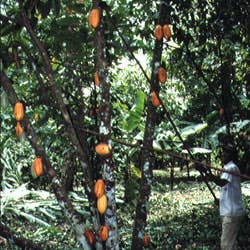
From Cacao Bean to Chocolate Bar
Follow the life cycle of rare, exquisite criollo cacao as it journeys from Venezuelan farm to grocery shelf.
Follow the life cycle of rare, exquisite criollo cacao as it journeys from Venezuelan farm to grocery shelf.
1. Cacao trees are often interplanted with tall shade trees in Venezuela, as elsewhere, to protect them from direct sunlight. Pods grow on the trunks and larger branches of the trees, and take five to six months to ripen. Fruit on the higher branches is harvested with blades on long handles; lower down, it's cut with machetes.
2. The pods are cut open with machetes to reveal between 20 and 40 beans each, surrounded by a mass of sticky, white pulp. Traditionally, this was done immediately after harvest; today, pods are sometimes first stored whole for a few days to prime them for fermentation.
3. Fermenting begins when the beans come into contact with the air. Workers use a stick to gauge the depth of the mass in a vara, or measuring box, to determine the wage of the harvester, before transferring it to the fermentation bin. During fermentation, the pulp disintegrates, producing steamy heat and a pervasive, yeasty, sour smell. It is at this point that the beans first develop their complex characteristics.
4. Drying of the beans after fermentation is done on slatted wooden trays in the open air. The beans are spread out evenly and raked periodically so that they dry uniformly. As the beans dry, their colors deepen, turning them into a carpet of sepia, umber, and mocha.
5. Aeration of the dried beans during storage is important to prevent the formation of mold. Workers toss the beans with a shovel to expose them evenly to the air.
6. Grading of the beans is done mechanically at the larger farms; smaller producers do it by hand. From baskets, the dried beans are transferred to burlap bags and transported to local selling stations, where they may be bought by large companies for export—or for processing within Venezuela itself.
7. Processing includes roasting and milling, then conching and tempering—all done with state-of-the-art European equipment. Then the cacao emerges in familiar form, as bars of chocolate, ready to be wrapped and sold.
Keep Reading
Continue to Next Story










